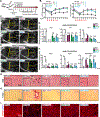Cooperative sensing of mitochondrial DNA by ZBP1 and cGAS promotes cardiotoxicity
- PMID: 37352855
- PMCID: PMC10330843
- DOI: 10.1016/j.cell.2023.05.039
Cooperative sensing of mitochondrial DNA by ZBP1 and cGAS promotes cardiotoxicity
Abstract
Mitochondrial DNA (mtDNA) is a potent agonist of the innate immune system; however, the exact immunostimulatory features of mtDNA and the kinetics of detection by cytosolic nucleic acid sensors remain poorly defined. Here, we show that mitochondrial genome instability promotes Z-form DNA accumulation. Z-DNA binding protein 1 (ZBP1) stabilizes Z-form mtDNA and nucleates a cytosolic complex containing cGAS, RIPK1, and RIPK3 to sustain STAT1 phosphorylation and type I interferon (IFN-I) signaling. Elevated Z-form mtDNA, ZBP1 expression, and IFN-I signaling are observed in cardiomyocytes after exposure to Doxorubicin, a first-line chemotherapeutic agent that induces frequent cardiotoxicity in cancer patients. Strikingly, mice lacking ZBP1 or IFN-I signaling are protected from Doxorubicin-induced cardiotoxicity. Our findings reveal ZBP1 as a cooperative partner for cGAS that sustains IFN-I responses to mitochondrial genome instability and highlight ZBP1 as a potential target in heart failure and other disorders where mtDNA stress contributes to interferon-related pathology.
Keywords: STING; Z-DNA; ZBP1; cGAS; cardiotoxicity; heart failure; mitochondrial DNA; type I interferon.
Copyright © 2023 The Author(s). Published by Elsevier Inc. All rights reserved.
Conflict of interest statement
Declaration of interests The authors declare no competing interests.
Figures







References
-
- Szczesny B, Marcatti M, Ahmad A, Montalbano M, Brunyánszki A, Bibli S-I, Papapetropoulos A, and Szabo C (2018). Mitochondrial DNA damage and subsequent activation of Z-DNA binding protein 1 links oxidative stress to inflammation in epithelial cells. Sci. Rep 8, 914. 10.1038/s41598-018-19216-1. - DOI - PMC - PubMed
Publication types
MeSH terms
Substances
Grants and funding
LinkOut - more resources
Full Text Sources
Molecular Biology Databases
Research Materials
Miscellaneous

